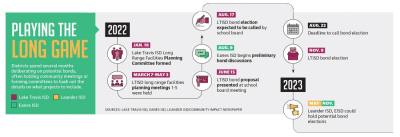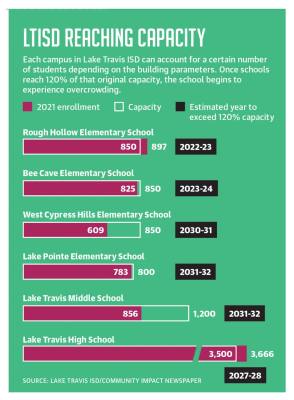As the student population continues to rise in western Travis County, Lake Travis ISD will consider calling a bond election in November for $703 million worth of facilities, improvements, technology and more.
Superintendent Paul Norton said new schools must be built to accommodate this level of growth. LTISD gained 1,763 students from 2015-20, making it one of the fastest-growing districts in the region, according to the district’s 2022 demographic report. Bee Cave and Rough Hollow elementary schools are set to reach capacity in the next two years.
"A big piece of this bond is planning for the future, making sure we have facilities and classrooms to accommodate the student growth to where we can have great classrooms for students,” Norton said.
Propositions A, B and C cover the following areas of spending, respectively: school district facilities, technology and athletic facilities.
As of publication, the line-by-line breakdown of each project in the bonds was not available, but the district said it is working to develop these materials.
In the wake of rising need for facilities, the district has spent months developing plans for the bond election in November. A vote on whether to hold a bond election was scheduled to be held at the next regularly scheduled board meeting Aug. 17, after press time.
Addressing overcrowding
Enrollment in LTISD is expected to at least double from 2010-30, going from around 7,000 in 2010 to between 14,000 and 16,000 in 2030, according to district documents. To alleviate overcrowding at select campuses across the district, LTISD will need to build two additional elementary schools in the next three years, Norton said.
The list of projects included in the bonds was determined by the Long Range Facilities Planning Committee. The committee is a group of parents, educators, business leaders, students and others who came together five times throughout March and April to discuss potential details of the bonds.
Proposition A includes $548.41 million for a new high school, two new elementary schools, campus improvements and more, while proposition B includes $60.79 million for technology improvements and software upgrades. Proposition C would allocate $93.8 million for a new competition arena and Cavalier Stadium renovations, among other projects.
One major priority of the bonds is to address the anticipated growth of the district over the next several years, Norton said. Each school has a dedicated capacity, but schools are considered full when they exceed 120% of that capacity.
“When you look at capacity, you’re looking at a comfortable classroom [and] auxiliary spaces such as the cafeteria and office space,” Norton said. “When you get to the 120%, that’s when you want to have another campus for those students to move into.”
Three schools in the district are at risk of passing the 120% threshold in the next five years, including Rough Hollow Elementary, set to surpass its capacity this upcoming school year. Bee Cave Elementary is set to pass this threshold in 2023-24, followed by the high school in 2027-28.
The district has control over attendance zones and could rezone campuses to address overcrowding now, but rezoning would have to occur again in the event the bonds pass. To prevent uprooting a group of students several times over a three- to four-year period, the district has decided to not pursue rezoning at this time, Norton said.
The board was originally scheduled to vote on whether to hold a bond election at the July 20 meeting. This meeting was postponed due to Norton’s absence; however, there were also a number of concerns raised by residents during the public comment section of the meeting.
Among the group of concerned residents was Susan Harbin, a frequent meeting attendee. Harbin requested the board postpone the decision to hold a bond election until more information about what was included in each bond was released. The district has more time to make decisions on projects such as the new high school, which has several years until it is set to reach capacity, she said.
“The board said the public has all the data that the committee has, and if that’s the case there really is no due diligence going on through this process of looking at detailed financial estimates,” Harbin said. “I think there’s a lack of community buy-in, especially with the athletic spending.”
While there are technically several years until the high school reaches capacity, it would take the district three and a half years to complete the new facility, Norton said. All aspects of the project considered, the high school would be done by fall 2026 if Proposition A was approved in November. The current high school is expected to reach the 120% capacity threshold in 2027.
There are other members of the community wholly in favor of the bonds and the benefit they would bring to students, such as LTISD parent Amy Hesse. The total cost of the bonds may seem high, but she said she believes the cost is competitive compared to other districts.
“We need these schools. We don’t have infrastructure where we can accommodate other buildings, and if we do they’re not in the correct location,” Hesse said. “We are in an inflationary economy; our dollars right now are worth the most that they will be. If we kick this can down the road and we do not have a bond in November, it’s going to cost us more dollars and more interest rates.”
Regardless of the benefit, the $703 million bond remains the largest bond total LTISD has ever considered, Norton said. Due to the district’s debt management and early repayment of bonds in the past, the district has the capacity to hold a bond election of this size. This bond will not directly increase district tax rates; however, households will still see an increased tax bill due to the rising appraisal values of property in the area, according to the district.
Comparing the bonds
Elementary schools No. 8 and No. 9 are expected to cost $50 million and $54.6 million, respectively.
Land for Elementary School No. 8 was purchased in May off Bee Creek Road and is expected to open in 2024. The location for Elementary School No. 9 has not been confirmed by the district at this time, Norton said.
The new high school is slated to cost $236 million total and is anticipated to go on a parcel of land owned by the district off Reimers Peacock Road near West Cypress Hills, according to district documents.
The financial estimates for the new schools are much higher than those included in the $253 million 2018 bond used for a new elementary and middle school, among other projects. The 2018 bond financed Elementary School No. 7, now known as Rough Hollow Elementary School, and Middle School No. 3, or Bee Cave Middle School.
At the time, Rough Hollow Elementary cost $33.1 million, while Bee Cave Middle School cost $76.2 million. The reason the new bonds cost so much is because they include more projects, LTISD Chief Financial Officer Pam Sanchez said.
“The amount this go-around includes larger ticket items than ever before,” Sanchez said. “We have looked out [for] our needs, but also considering student growth projections, which are pretty significant.”
Upcoming bond plans
Similar to LTISD, Eanes and Leander ISDs have upcoming plans of their own to pursue another bond election.
As another fast-growth district expecting as many as 9,000 new students by 2031, LISD has had to change gears after two out of three bond propositions totaling around $760 million failed to pass at the polls last November. One of the failed propositions would have allocated $727.2 million to the construction of new schools and facilities as well as the renovation of existing ones to accommodate growth.
Updated plans from the Long Range Facilities Planning Committee in LISD have pared down the number of schools being built from eight by 2026 to six over a 10-year period. These new plans also include ways to maximize use of existing facilities, such as adding portable buildings and rezoning school boundaries.
“Part of our dilemma is that we have shrinking student populations in part of the district, and then exploding and growing student populations,” LISD Superintendent Bruce Gearing said. “Part of what we’re doing in that 10-year plan [is] making sure that we have a really clear understanding of how we’re going to balance those two opposing forces.”
EISD held its first discussions regarding a possible bond Aug. 9. While the district may not be seeing increased enrollment, several of its facilities are in need of updates, Superintendent Jeff Arnett said.
The presentation indicated the district had the potential to hold a bond election in May 2023 for $110 million-$130 million for the modernization of aging campus facilities. Additional discussions were had about another major bond being held in 2025 for about $250 million worth of major projects.
At the next regularly scheduled EISD board meeting on Aug. 23 , the district will discuss several possible projects to be included in the bonds.
“I think we have some fantastic schools, and we have some facilities that are a part of that history,” Arnett said. “But there are certainly some needs, and there’s some attention that we think needs to be given to our facilities, as well as just the ongoing maintenance and operations.”







